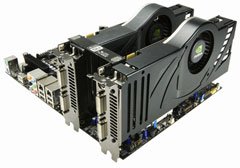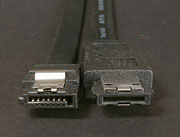Choose to buy a PC board (part 2)
 Choose to buy a PC board (part 2) Picture 1 Part I: Select CPU, chipset, memory
Choose to buy a PC board (part 2) Picture 1 Part I: Select CPU, chipset, memory
Choosing a motherboard should follow certain guidelines, and if you choose the right one, you won't have to worry about future upgrades .
* Graphics hardware : Graphics hardware (also known as graphics processing unit - GPU) is the third important component of a system, after CPU and chipset. The biggest concern for graphics is price, performance and upgrading.
 Choose to buy a PC board (part 2) Picture 2 The cheapest option is the integrated graphics chipset. Integrated graphics processors usually only have basic 2D and 3D functions, and often use system memory instead of dedicated graphics memory. All major vendors (AMD, Intel nVidia and VIA) offer integrated graphics for some chipset models. This is the best choice for users who need less multimedia experience, work in the office and run light applications.
Choose to buy a PC board (part 2) Picture 2 The cheapest option is the integrated graphics chipset. Integrated graphics processors usually only have basic 2D and 3D functions, and often use system memory instead of dedicated graphics memory. All major vendors (AMD, Intel nVidia and VIA) offer integrated graphics for some chipset models. This is the best choice for users who need less multimedia experience, work in the office and run light applications.
Active furniture is currently available on over 60% of used computer systems. However, this technology lacks the required performance for gaming. For users who want to play games on a PC, choosing a motherboard requires at least one PCI Express x16 slot, for discrete graphics from ATI / AMD or nVidia.
PCI Express currently has two versions. The newer version can run at 5GHz, double the old version. This difference does not affect the current GPUs (or most other peripherals), but it will be a problem when upgrading later. If you need a really strong board, PCI Express must choose the latest version.
If money doesn't matter to you and your goal is to play games, the choice is a bit different. It is a board that needs to support multiple GPUs, and these types of boards are usually very expensive. The only option for multi-GPU motherboards will be SLI (for nVidia graphics cards) or CrossFire (for ATI cards). These are two technologies that allow mounting multiple graphics cards running on one system. According to the current situation, SLI is still the most "top"; however, it only supports each nVidia chipset and Intel's Skulltrail motherboard.
Another issue to consider is the graphical interface. You will have 3 choices: VGA, DVI, and HDMI. VGA is a traditional 15-pin analog monitor designed for CRT monitors. DVI is a digital connection for LCD monitors. While HDMI is another version of DVI, it requires a new digital rights management (DRM) technology to play Blu-ray discs and other high-definition content.
* Sound : If used for normal purposes, the integrated audio is also quite okay but their quality is not high. AC97 is the old audio standard and is currently being replaced by HD Audio. You should upgrade to HD Audio with quality that is slightly improved. If you want to enjoy more realistic sound, you need a separate sound card, and the board needs to have an additional PCI-E slot.
 Choose to buy a PC board (part 2) Picture 3 * Storage : Just like memory, basic storage tends to go straight but also faces some obstacles in platform switching. In the past few years, the storage sector has undergone many transition stages: from Parallel ATA to Serial ATA (SATA), and currently SATA 3Gbps. Compared to SATA 1.5Gbps version, SATA 3Gbps version is more efficient, especially useful for video editing and other heavy-duty tasks.
Choose to buy a PC board (part 2) Picture 3 * Storage : Just like memory, basic storage tends to go straight but also faces some obstacles in platform switching. In the past few years, the storage sector has undergone many transition stages: from Parallel ATA to Serial ATA (SATA), and currently SATA 3Gbps. Compared to SATA 1.5Gbps version, SATA 3Gbps version is more efficient, especially useful for video editing and other heavy-duty tasks.
Most hard drives use SATA, while some older DVD +/- RW drives use Parallel ATA. Most current motherboards support 4 or more SATA ports (even 10 ports), and this is very handy for users.
eSATA is a new standard for connecting external hard drives via SATA because of FireWire or USB. eSATA has higher performance than the old 2 standards, and has great management and stability. Although not as popular as USB, eSATA will be quite popular in the future.
Another storage related issue is RAID, which is currently the standard of many modern boards. You can use RAID 0 (connect 2 hard drives) to speed up data recording and writing; or RAID 1 to increase readability and speed. Meanwhile RAID 5 requires at least 3 hard drives and RAID 6 (business only) requires at least 4 hard drives. Both standards enhance data stability and readability, while the write performance is acceptable, and data overwriting is a bit less than RAID 1. Most PC systems do not need a lot of hard drives, but if there is more, the better. For video editing or multimedia tasks, you should use RAID 0, 1, or 5.
Network : Most motherboards now have integrated gigabit ethernet ports, so you won't need to worry about this. If it is a desktop PC, Wi-Fi is not really necessary, and most boards do not have this feature to minimize costs.
Peripherals : Peripherals may include: USB 2.0, FireWire, PS / 2, serial port and parallel. Among these features USB 2.0 is the most necessary, and FireWire is also quite useful if you use a handheld camcorder.
Manufacturing form : The final note for a board is a manufacturing form. Most of the current boards use ATX form; but if you need a smaller size board, you should choose the microATX.
 Choose to buy a PC board (part 2) Picture 4 Choose to buy a motherboard (end part)
Choose to buy a PC board (part 2) Picture 4 Choose to buy a motherboard (end part)
You should read it
- Choose to buy a motherboard (end part)
- Why is the PCI Express port on the motherboard different in size? What does x16, x8, x4 and x1 mean?
- Things to know when choosing to buy mainboard
- List of the best graphics cards according to the price segment
- Choose to buy the right board for your PC
- Does your PC need more than one graphics card?
- Top 7 best AMD graphics cards (GPUs) 2020
- 7 things you need to know about integrated and dedicated graphics cards
- Use GPU-Z to analyze graphics card parameters
- How to fix the NVIDIA graphics card error is not displayed in Device Manager
- How to speed up onboard graphics card on window
- Is the Intel HD Graphics 620 graphics card strong? What games can you play?





 Why is the Apple printed circuit board black while most other manufacturers are green?
Why is the Apple printed circuit board black while most other manufacturers are green? What is a Board Game?
What is a Board Game? How to decorate a beautiful 20/11 board for the classroom, 20/11 board decoration sample
How to decorate a beautiful 20/11 board for the classroom, 20/11 board decoration sample Advantages and disadvantages of computer board brands in the market
Advantages and disadvantages of computer board brands in the market What is the most powerful single-board computer (SBC) today?
What is the most powerful single-board computer (SBC) today? Suggest good ideas for bulletin boards for schools
Suggest good ideas for bulletin boards for schools